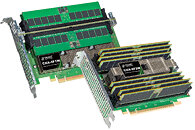- Joined
- Oct 9, 2007
- Messages
- 46,476 (7.66/day)
- Location
- Hyderabad, India
| System Name | RBMK-1000 |
|---|---|
| Processor | AMD Ryzen 7 5700G |
| Motherboard | ASUS ROG Strix B450-E Gaming |
| Cooling | DeepCool Gammax L240 V2 |
| Memory | 2x 8GB G.Skill Sniper X |
| Video Card(s) | Palit GeForce RTX 2080 SUPER GameRock |
| Storage | Western Digital Black NVMe 512GB |
| Display(s) | BenQ 1440p 60 Hz 27-inch |
| Case | Corsair Carbide 100R |
| Audio Device(s) | ASUS SupremeFX S1220A |
| Power Supply | Cooler Master MWE Gold 650W |
| Mouse | ASUS ROG Strix Impact |
| Keyboard | Gamdias Hermes E2 |
| Software | Windows 11 Pro |
SMART Modular Technologies, Inc. ("SMART"), a division of SGH (Nasdaq: SGH) and a global leader in memory solutions, solid-state drives, and advanced memory, announces its new family of Add-In Cards (AICs) which implements the Compute Express Link (CXL) standard and also supports industry standard DDR5 DIMMs. These are the first in their class, high-density DIMM AICs to adopt the CXL protocol. The SMART 4-DIMM and 8-DIMM products enable server and data center architects to add up to 4 TB of memory in a familiar, easy-to-deploy form factor.
"The market for CXL memory components for data center applications is expected to grow rapidly. Initial production shipments are expected in late 2024 and will surpass the $2 billion mark by 2026. Ultimately, CXL attach rates in the server market will reach 30% including both expansion and pooling use cases," stated Mike Howard, vice president of DRAM and memory markets at TechInsights, an intelligence source to semiconductor innovation and related markets.

"The CXL protocol is an important step toward achieving industry standard memory disaggregation and sharing which will significantly improve the way memory is deployed in the coming years," said Andy Mills, senior director of advanced product development at SMART Modular, reinforcing Howard's market analysis and SMART's rationale for developing this family of CXL-related products.
SMART's 4-DIMM and 8-DIMM AICs are built using advanced CXL controllers which eliminate memory bandwidth bottlenecks and capacity constraints for compute-intensive workloads encountered in Artificial Intelligence (AI), high performance computing (HPC), and Machine Learning (ML). These emerging applications require larger amounts of high-speed memory that exceed what current servers can accommodate. Attempts to add more memory via the traditional DIMM-based parallel bus interface is becoming problematic due to pin limitations on CPUs, so the industry is turning to CXL-based solutions which are more pin efficient.
Technical Specifications
About SMART's 4-DIMM and 8-DIMM DDR5 AICs
Visit SMART's 4-DIMM product page and 8-DIMM AIC product page for further information, and the CMM/CXL family page for information on SMART's other products using the CXL standard. SMART will provide samples to OEMs upon request. These new CXL-based AIC products join SMART's ZDIMM line of DRAM as ideal solutions for demanding memory design-in applications.
View at TechPowerUp Main Site
"The market for CXL memory components for data center applications is expected to grow rapidly. Initial production shipments are expected in late 2024 and will surpass the $2 billion mark by 2026. Ultimately, CXL attach rates in the server market will reach 30% including both expansion and pooling use cases," stated Mike Howard, vice president of DRAM and memory markets at TechInsights, an intelligence source to semiconductor innovation and related markets.

"The CXL protocol is an important step toward achieving industry standard memory disaggregation and sharing which will significantly improve the way memory is deployed in the coming years," said Andy Mills, senior director of advanced product development at SMART Modular, reinforcing Howard's market analysis and SMART's rationale for developing this family of CXL-related products.
SMART's 4-DIMM and 8-DIMM AICs are built using advanced CXL controllers which eliminate memory bandwidth bottlenecks and capacity constraints for compute-intensive workloads encountered in Artificial Intelligence (AI), high performance computing (HPC), and Machine Learning (ML). These emerging applications require larger amounts of high-speed memory that exceed what current servers can accommodate. Attempts to add more memory via the traditional DIMM-based parallel bus interface is becoming problematic due to pin limitations on CPUs, so the industry is turning to CXL-based solutions which are more pin efficient.
Technical Specifications
About SMART's 4-DIMM and 8-DIMM DDR5 AICs
- Available in type 3 PCIe Gen 5 Full Height, Half Length (FHHL) PCIe form factor.
- The 4-DIMM AIC (CXA-4F1W) accommodates four DDR5 RDIMMs with a maximum of 2 TB of memory capacity when using 512 GB RDIMMs, and the 8-DIMM AIC (CXA-8F2W) accommodates eight DDR5 RDIMMs with a maximum of 4 TB of memory capacity.
- The 4-DIMM AIC uses a single CXL controller implementing one x16 CXL port while the 8-DIMM AIC uses two CXL controllers to implement two x8 ports, both resulting in a total bandwidth of 64 GB/s.
- The CXL controllers support "Reliability, Availability, and Serviceability" (RAS) features, and advanced analytics.
- Both offer enhanced security features with in-band or side band (SMBus) monitoring capability.
- To accelerate memory processing, these add-in cards are compatible with SMART's Zefr ZDIMMs.
Visit SMART's 4-DIMM product page and 8-DIMM AIC product page for further information, and the CMM/CXL family page for information on SMART's other products using the CXL standard. SMART will provide samples to OEMs upon request. These new CXL-based AIC products join SMART's ZDIMM line of DRAM as ideal solutions for demanding memory design-in applications.
View at TechPowerUp Main Site




